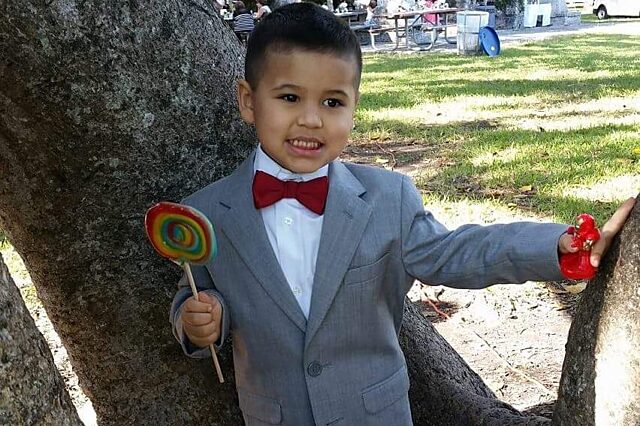Caden Buth’s Story

Four-year-old Caden Buth is energetic. He’s happy, loves to talk, loves to run and enjoys life. However, sometimes those things that he loves to do are difficult. At four weeks old, Caden was diagnosed with Hemophilia A, and he’s not had an easy road since.
“The doctors diagnosed Caden with the disease after he had a circumcision,” says Christina Buth, Caden’s mom. “We were really lucky that the physician on-call during the circumcision was UF Health Shands Children’s Hospital Pediatric Hematologist Tung Wynn, M.D. He’s been treating Caden ever since, and we could not be more grateful.”
Having a child with hemophilia can be scary, and for Christina and her husband, they did not know a lot about the disease when Caden was first diagnosed.
“My husband and I were in shock and denial at first,” says Christina. “After Caden had a severe, spontaneous bleed in his elbow early on in his life, we realized that his condition is very serious. He can start bleeding from nothing at all. I’ll never forget the shrill cry he let out when he started bleeding that night.”
After that incident, the Buths started seeking support from the hemophilia community. Being able to talk to families who are going through similar experiences has been really helpful for them. They even started attending a yearly hemophilia foundation symposium.
“We immersed ourselves in the hemophilia community,” says Christina. “We started doing a lot of research on Caden’s condition, and we asked ourselves what we could do to help him. All of the support we started receiving from others led us to a place of acceptance.”
The main treatment for hemophilia is called factor replacement therapy, but since Caden’s diagnosis, he’s had some severe setbacks that have affected his treatment. In September 2013, just before Caden turned one, he developed inhibitors to his factor replacement, making the treatment ineffective. The infusions of factor are supposed to help replace the clotting factor in the body that's missing or low. For Caden, however, his body started producing neutralizing antibodies to the factor. Hematologists gave him about a year to allow the antibodies to fade away. After Caden was diagnosed with inhibitors, he was given a bypassing agent to allow him to continue treatment. Since his inhibitor diagnosis, Caden has had permanent lines placed into his veins, known as a mediport and a broviac catheter, and has been on many different medications, some having to be administered every two hours.
“Inhibitors are one of the most serious complications that a hemophilia patient can face,” said Dr. Wynn. “They can make the treatment of hemophilia very challenging when we can no longer use most widely available factor replacement therapies."
In August 2014, Caden started receiving immune tolerance treatment, or ITT, when it appeared his inhibitors wouldn’t fade any further, and he began having more frequent bleeding. He received this until January 2015 as solution to completely eliminate the inhibitors. Then, Caden was diagnosed with a port infection—another setback. During this whole time, his inhibitor titers continued to climb instead of reducing. The amount of inhibitor present is called an inhibitor titer, and it is measured in Bethesda units, or BU. The higher the inhibitor titer, the more inhibitor is present in the blood. Anything less than 5.0 BU is considered low titer, and anything above is considered high titer. Around the time Caden was first tested, his titers were over 500 BU. By January 2015, the titers were close to 3,000 BU. And by July 2015, Caden’s titers were between 10,000 and 20,000 BU.
Caden has experienced everything from shoulder bleeds to knee bleeds to mouth bleeds to rib bleeds, to name a few. Even with all of this, he continues to fight and has remained positive. He’s about to begin a new treatment called rapamycin to suppress his immune system and reduce his inhibitors further, and his mom hopes he can begin ITT again to completely get rid of his inhibitors.
“I know it doesn’t sound like it, but we consider ourselves very lucky,” says Christina. “Caden does not bleed as much as someone with severe Hemophilia A should, especially someone who is not responding to treatment. Caden continues to be a fun-loving boy, and we continue to fight for him every day to come up with solutions with our wonderful UF Health physicians.”
As an example of Caden not letting this disease get him down, a few weeks ago Caden suffered a spontaneous knee bleed that required hospitalization. He could not even walk for a few days, and of course, his parents were scared. Once he was discharged, Caden needed to rest, but his mom walked in on him doing a handstand on the couch. Shocked, Christina asked Caden why he was doing that and reminded him he needed rest. Caden responded, “But mommy, I’m not on my knee.”
Dr. Wynn added, “Caden and his family embody the many challenges that we are faced with in the treatment of hemophilia and the hurdles that we try to overcome to assure that his childhood is as normal as any other child’s. It is a gift to be able to see Caden able to run, dance and play.”